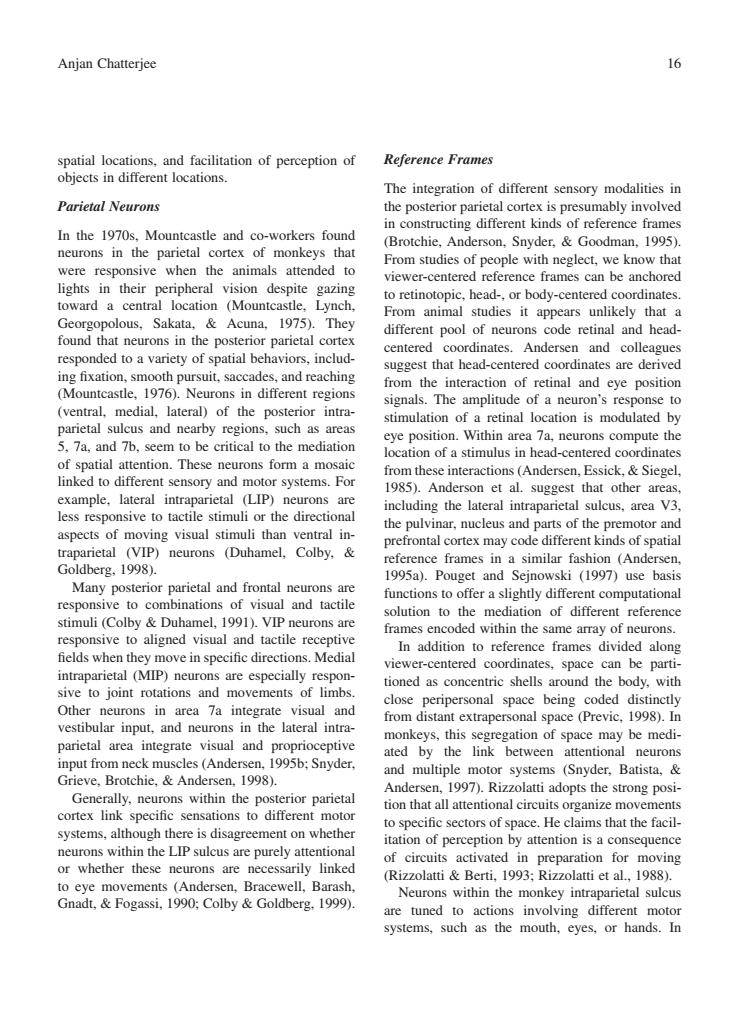正在加载图片...

Anian chatteriee 16 Reference Frames The integration of different sensory modalities in Parietal Neurons ctedifereatn点Psabyiaoled al con in co In the 1970s,Mountcastle and co-workers found (Brotchie.Anderson.Snyder.Goodman,1995 neurons in the parietal cortex of monkeys that were responsive when the animals attended to From studies of people with neglect,we know that viewer-centered reference frames can be anchored lights in their peripheral vision despite gazing toward a central location (Mountcastle.Lynch to retinotopic,head-,or body-centered coordinates Georgonolous Sakata Acuna 1975)They From animal studies it appears unlikely that a found that neurons in the posterior parietal cortex different pool of neurons code retinal and head- responded to a variety of spatial behaviors,includ- centered coordinates.Andersen and colleagues suggest that head-centered coordinates are derived ing fixation.smooth pursuit.saccades.and reachins (Mountcastle,1976).Neurons in different region from the interaction of retinal and eye position signals.The amplitude of a neuron's response to (ventral.medial.lateral)of the stimulation of a retinal location is modulated by 5.7a.and 7b.seem to be critical to the mediation eye position.Within area 7a,neurons compute the location of a stimulus in head-centered coordinates of spatial attention These ne fo linked to different sensory and motor ystem from these interactions (Andersen,Essick,Siegel Fo 1985).Anderson et al.suggest that other areas ietal (LIP) onsive to tactile stimuli or the dir including the lateral intraparietal sulcus,area V3 aspects of moving visual tral in the pulvinar,nucleus and parts of the premotor and (VIP) neurons (Duhar prefrontal cortex may code different kinds of spatial 1998 reference frames in a similar fashion (Andersen. and 1995a)Pouget and Seinowski (1997)use hasis Man functions to offer a slightly different computational of and 1991).VIP neurons aligned In addition to reference frames divided along viewer-cent ered co are especi tioned as concentrie shells around the body an from distant ex space 1998.正 ons in kevs paretal are and proprioceptive ated by the link n nput from neck muscle (Andersen,1995b:Snyder. (Snyder.Batist Grieve,Brotchie,&Ande rsen.1998) .R Generally,neurons within the posterior parietal adopts th cortex link specific sensations to different moto space.He claims that the systems.although there is disagreement on whethe pe neurons within the LIP sulcus are purely attentional m or whether these neurons are necessarily linked R 1993:R to eye movements (Andersen,Bracewell,Barash Gnadt,Fogassi,1990:Colby Goldberg.1999). Neuron withi ain the mon are tuned acti ving diffe systems,such as the mouth,eyes,or hands spatial locations, and facilitation of perception of objects in different locations. Parietal Neurons In the 1970s, Mountcastle and co-workers found neurons in the parietal cortex of monkeys that were responsive when the animals attended to lights in their peripheral vision despite gazing toward a central location (Mountcastle, Lynch, Georgopolous, Sakata, & Acuna, 1975). They found that neurons in the posterior parietal cortex responded to a variety of spatial behaviors, including fixation, smooth pursuit, saccades, and reaching (Mountcastle, 1976). Neurons in different regions (ventral, medial, lateral) of the posterior intraparietal sulcus and nearby regions, such as areas 5, 7a, and 7b, seem to be critical to the mediation of spatial attention. These neurons form a mosaic linked to different sensory and motor systems. For example, lateral intraparietal (LIP) neurons are less responsive to tactile stimuli or the directional aspects of moving visual stimuli than ventral intraparietal (VIP) neurons (Duhamel, Colby, & Goldberg, 1998). Many posterior parietal and frontal neurons are responsive to combinations of visual and tactile stimuli (Colby & Duhamel, 1991). VIP neurons are responsive to aligned visual and tactile receptive fields when they move in specific directions. Medial intraparietal (MIP) neurons are especially responsive to joint rotations and movements of limbs. Other neurons in area 7a integrate visual and vestibular input, and neurons in the lateral intraparietal area integrate visual and proprioceptive input from neck muscles (Andersen, 1995b; Snyder, Grieve, Brotchie, & Andersen, 1998). Generally, neurons within the posterior parietal cortex link specific sensations to different motor systems, although there is disagreement on whether neurons within the LIP sulcus are purely attentional or whether these neurons are necessarily linked to eye movements (Andersen, Bracewell, Barash, Gnadt, & Fogassi, 1990; Colby & Goldberg, 1999). Reference Frames The integration of different sensory modalities in the posterior parietal cortex is presumably involved in constructing different kinds of reference frames (Brotchie, Anderson, Snyder, & Goodman, 1995). From studies of people with neglect, we know that viewer-centered reference frames can be anchored to retinotopic, head-, or body-centered coordinates. From animal studies it appears unlikely that a different pool of neurons code retinal and headcentered coordinates. Andersen and colleagues suggest that head-centered coordinates are derived from the interaction of retinal and eye position signals. The amplitude of a neuron’s response to stimulation of a retinal location is modulated by eye position. Within area 7a, neurons compute the location of a stimulus in head-centered coordinates from these interactions (Andersen, Essick, & Siegel, 1985). Anderson et al. suggest that other areas, including the lateral intraparietal sulcus, area V3, the pulvinar, nucleus and parts of the premotor and prefrontal cortex may code different kinds of spatial reference frames in a similar fashion (Andersen, 1995a). Pouget and Sejnowski (1997) use basis functions to offer a slightly different computational solution to the mediation of different reference frames encoded within the same array of neurons. In addition to reference frames divided along viewer-centered coordinates, space can be partitioned as concentric shells around the body, with close peripersonal space being coded distinctly from distant extrapersonal space (Previc, 1998). In monkeys, this segregation of space may be mediated by the link between attentional neurons and multiple motor systems (Snyder, Batista, & Andersen, 1997). Rizzolatti adopts the strong position that all attentional circuits organize movements to specific sectors of space. He claims that the facilitation of perception by attention is a consequence of circuits activated in preparation for moving (Rizzolatti & Berti, 1993; Rizzolatti et al., 1988). Neurons within the monkey intraparietal sulcus are tuned to actions involving different motor systems, such as the mouth, eyes, or hands. In Anjan Chatterjee 16